We got to the Mile 11 aid station and I thought:
You’ve got to be fucking kidding me. This cannot be happening right now…
It was the first checkpoint of Elephant Mountain 50 mile ultramarathon.
Five other Tribal Athletes came in right behind me.
And we had a huge problem…
We were 12 minutes ahead of cutoff
It was only 2.5 hours into the 16 hour race
Our back group was moving slower than I expected
My mindset was plummeting into doubt and urgency
In the final 2 miles leading into that Aid Station, I felt myself drifting into an old habit:
Trying to get others to go faster by pushing ahead of them.
The athlete in me was trying to will us forward.
I’ve done the same thing riding my bike with my wife. I did it at times in last year’s Team Ultra at Zion 100.
And just like those times, it wasn’t working. At all.
Something had to change. Fast.
I saw Tribal Prof.
on the far side of the Aid Station and hustled over to him.He had been in the back group (running with and coaching 3 other athletes) from the onset of the race.
“How are the guys doing back there?? We’re only 12 minutes ahead of the cutoff…”
I was searching for reassurance that what I felt happening wasn’t the case.
I wanted someone to tell me our Team Race wasn’t blowing up before it even really began.
I was avoiding a core truth I felt surfacing in my gut:
Just showing up wasn’t sufficient.
Goldstein hit me straight:
“We need you in the back.”
Lesson 1: Leaders Don’t Just Participate
I thought the race would go down like this.
50 miles
13 total Tribal athletes
3 running fast in the front
7 in the middle (doing just fine) with me coaching them
3 bringing up the rear, with an experienced athlete or other coach helping them
My “prediction” was really a hope.
And now looking back, I thought I could get away with just participating.
I thought the whole team could get across the finish line without me having to do anything special.
And here we were…
not even 3 hours into the race
guys struggling more than I expected
my responsibility staring me dead in the eye
Just showing up wasn’t sufficient.
Goldstein’s message tapped into a part of me I knew was there, but that I had to work to let out:
The leader inside me.
Lesson 2: Accept The Challenge
I made sure our guys got what they needed at the Aid Station and ushered them to get back out on the course.
I needed a moment to collect myself before transitioning from half athlete/half coach to 100% coach.
Plus, I thought it would be a good idea to take a dump before embarking on the 12 mile stretch to the next Aid Station.
So I hit the port-a-potty.
There was no pep talk, no pity party, no prayer.
Just a quick number 2 and an acceptance of what my team needed.
Lesson 3: Lead From The Back
I caught up with our two rear athletes (Cam and Stephanos) and felt out the vibe for our first half mile together.
“We can run here” I called out at each flat and downhill stretch, gauging responsiveness and body language.
“How you feeling?” I asked, in hopes we could speak some life into our group.
Cam’s response: “I’m just putting one foot in front of the other…”
Stephanos’s: “I’m ok…”
Thoughts of “how the fuck are we going to make it another 38+ miles??” attacked my mind, like ospreys diving into the ocean at 200 miles per hour.
I was so tempted to attach to the negativity.
It would almost be relaxing. It could give me relief. It would offload some of the pressure…
But I chose to resist them. I knew I would never make it if this negative thinking took control of my mind.
No one else knew it, but this was my internal turning point in the race.
The temptations of my lower self danced in my mind like a desert mirage of hula girls shaking their hips on the beach in Maui.
And I knew this couldn’t be the way my day went…
I directed all my attention on what was going well.
These athletes were rising up to my requests to run
The next Aid Station cutoff time was more relaxed
The entire Tribal Team was in front of me
Stephanos caught up to Goldstein and the 3 other athletes he was with.
Cam and I settled in to bringing up the rear.
Lesson 4: Faith Is What You Do
I spent the next two hours speaking personal power into existence.
You can do this dude.
That was a GREAT section.
We are not tapping out on this thing.
You can run. I know you can.
That was a GREAT effort. That was so strong.
We are moving so steady. We are fine right here.
I believe in you dude. I know you can do this.
We are not limping to the finish. We are not playing defense against this thing.
That was a GREAT mile. Let’s fucking go. We got this.
Reminders to eat and drink were sprinkled in between.
Cam and I shared food, water and struggle as our relationship reached a new level of truth.
Mile 13… Mile 14… Mile 15…
We endured together.
Mile 16… Mile 17… Mile 18…
My faith wasn’t in mile splits or sections of smooth trail.
I didn’t have a clue about any of that shit in the moment. I wasn’t even paying attention to those details.
Instead, my faith was in:
speaking personal power into existence
continually moving forward
eating and drinking
We kept going.
Goldstein and Company were a half mile ahead during this entire 8 mile stretch.
Cam and I would be within shouting distance whenever the trail carved and wrapped around connecting desert mountain bluffs.
“How you guys doing??!” I’d call out.
Goldstein’s response was the same every time…
“Consistent!”
The reassurance that my guys weren’t fading was freeing.
Part of me still wanted Cam and I to catch them. I wanted to feel the win of us making up ground.
But that wasn’t happening. And Goldstein’s message made me realize that was OK.
A new Tribal Theme emerged and solidified in real time:
Consistency not urgency.
Lesson 5: Ask For Help
After 2 hours that felt like 2 days for Cam and I, we caught up to Goldstein and Company.
Right away, I went to Goldstein and asked him to swap places and fall back.
I needed to change up my energy and run with some fresh faces.
I checked in with TA, Stephanos, Logan, Blaine and C Boyce.
We worked as a unit to stay on course at a creek crossing that almost sent us in the wrong direction.
And we kept on with humility and hope.
Humility that it was getting hard and hot.
Hope that we were only a few miles from the Mile 22.5 Aid Station.
After another 2 hours of grinding, we all made it.
Lesson 6: Leaders Go First
The biggest strategy mistake at Zion was perfectly dubbed “The Slinky Effect” by Trail Sensei and Tribal Athlete Louie Ruvolo.
In that race, we moved as a single unit of 9 athletes.
Each Aid Station went down like this:
Our athlete procession sprinkled in single file, over a quarter mile or so.
The athletes in the back would get to the Aid Station a few minutes behind athletes in the front.
The back athletes would feel urgency (there’s that word again) to refuel, restock and get out of the Aid Station to keep up with the athletes in the front.
The result?
Under-fueling, dehydration, panicked pacing.
And a lot of internal worry for athletes in the rear that they were holding the team back.
What happened at Mile 22.5 Aid Station saved our Team Pacing strategy.
And I never saw it coming…
When we got to the Aid Station, we slammed waters, PB+Js and rejoiced in the jubilation of making it to what Cam and I dubbed “Halftime of the Race.”
We also got new life seeing our Crew of Charlie (content guy), Shipley and Jack Porco
(pacers).
Then I heard
say:“I’m gonna go back out now and get ahead”
His decision to prioritize his needs (and put himself in a position to keep the team successful) prompted Stephanos and C Boyce to do the same a few minutes later.
Then Blaine asked for Jack Porco (Pacer) and the two of them headed out.
(Goldstein dubbed this Team Aid Station Strategy “The Slingshot Effect on our Coaches Recap Pod)
That left Goldstein and I at the Aid Station - and gifted us space to:
regroup emotionally
communicate on how specific athletes were doing
laugh and joke about how brutal parts of that stretch were
Our spirits were rejuvenated, we grabbed Shipley (Pacer) and assumed our new roles as Tribal Sweepers.
We had the confidence of being 75 minutes ahead of cutoff and all of our guys ahead of us.
All the doubt and panic that consumed my mind at Mile 11 had blown away, like dust in the desert wind.
Lesson 7: Use Charisma
The next 6 hours started with Goldstein, Shipley and myself consistently conquering miles from the back, and adding Tribal Athletes to our group one by one.
First Cam at Mile 24. Then Blaine and Jack Porco at Mile 27. Then Logan at 28. Then Stephanos at 29. Then C Boyce at 30.
In theory, each athlete was slowing for us to catch them.
But when we caught up to them, there was a different vibe…
shouts of excitement
fresh and enthusiastic conversation
life breathing energy in what were otherwise the hottest, longest miles of the race
We moved as a unit and stayed accountable to running the runnable stretches.
“We can run .1”
“Way to rise up”
“We can run 100 yards"
“This is a GREAT run segment”
“Our pacing is so strong right now. Let’s fuckin go”
“GREAT effort. Awesome job. We’re moving so well right now”
The guys ran when they didn’t want to. They didn’t complain. They showed up for themselves and the team.
Back when I arrived at the Mile 22.5 Aid Station, I felt euphoric. We had already been digging deeper than I expected us to all day - and we made it through.
When I ran into the Mile 36 Aid Station, I felt empowered. We earned those miles together as a team.
They were hot, steep and on jagged terrain. We were all low on (or out of) water.
I knew my guys were tired. All 4 athletes I was with were in the deep end of the biggest challenge of their life.
And how did they show up?
With courage.
They rose up for themselves (and the team). They didn’t break. And we made it.
There were tons of positives to focus on:
The longest stretches without aid (11 to 22.5 and 22.5 to 36) were behind us
The sun was setting and temps were cooling down
Our push to the finish was about to go down
Plus, we were 30+ minutes ahead of cutoff.
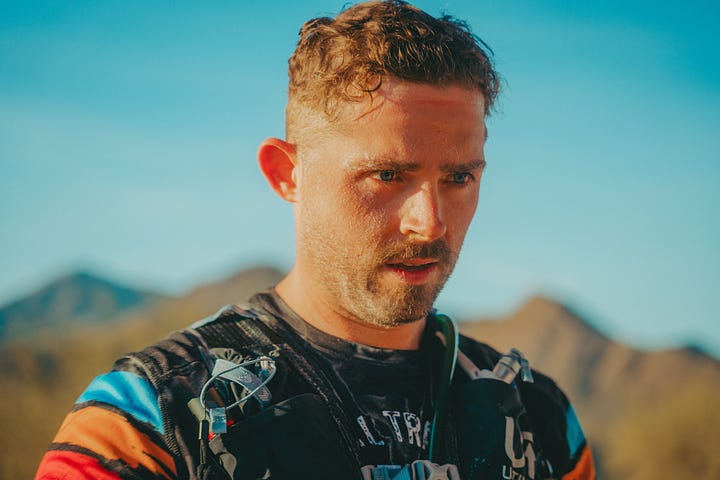

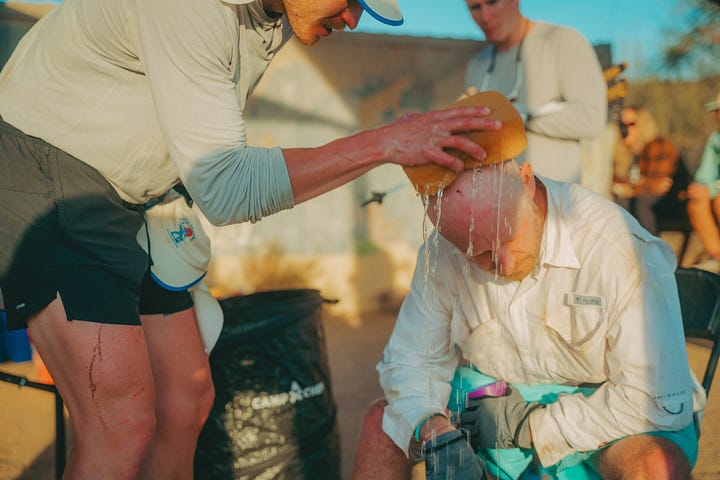
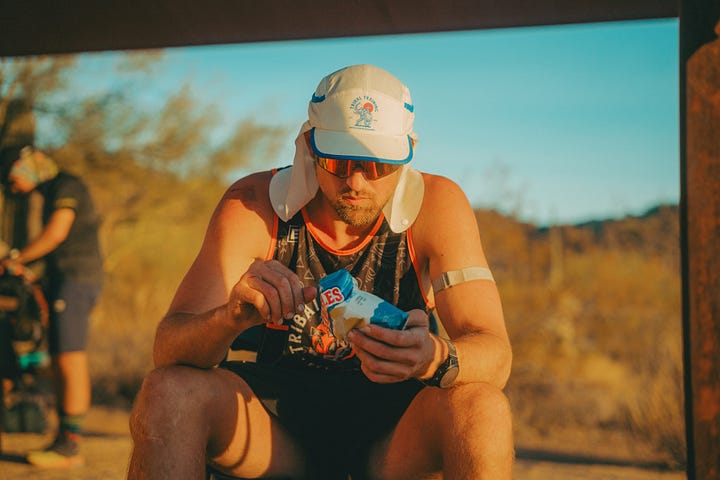
Lesson 8: Leadership Isn’t Management
The Slingshot Effect worked again coming out of 36, which left Goldstein and I free to recharge emotionally in the back.
But something even more important happened at the same time…
Our guys got space to go do their thing out on the trails for a bit.
There are times that it’s great to live coach and run right along side an athlete to bring out their best.
But too much of that can turn into riding an athlete’s ass all day.
Part of doing an ultramarathon is enjoying the mix of:
solitude
natural beauty
moving yourself forward, alone
Goldstein and I were intentional to stay back and move at a consistent pace (there’s that word again) that kept us ahead of cutoff.
We figured we’d catch up to our guys. But we weren’t in a rush to.
Lesson 9: Understand Timing
By mile 39, the Tribal Sweepers had picked up Cam and were gaining ground on athletes ahead.
As we moved through mile 42, we closed in on two headlights and prepared to bring good vibes.
But as soon as we got to them, I knew something was wrong…
Logan was hunched over on the side of the trail, resting on his poles.
He told us he hadn’t gotten water down in 5 hours. And he wanted his race to end.
Right away, our group finish was in doubt. I knew something needed to change.
But at the same time, I knew…
It wasn’t the time for a rah rah speech
It wasn’t the time to tell him he can tough it out
It wasn’t the time to remind him his “WHY” and tell him to do it for his family
Instead… it was the time to say…
“This is OK.
We’re not in any rush.
Let’s be open to trying something new”
By the Grace of God, Logan was standing 50 feet from a closed down Aid Station (the Mile 5.9 AS) that had fuel left for athletes to grab on their own.
Logan sat down in a chair as we collectively created space for relaxed troubleshooting.
1 swig of coke, 2 cramps and 4 heaves of puke later, Logan said…
“I actually feel a bit better”
We were back in the game.
Lesson 10: Know When To Follow
Our group of 5 (Cam, Shipley, Logan, Goldstein and me) did quick math on miles left and time to cutoff.
We didn’t need to rush. But we did need to get moving. And we needed to be consistent.
In the pitch dark desert night…
Under a sky sprinkled with stars…
And the golden glow of a waxing crescent moon…
Five headlights marched on together toward the finish line.
With the course GPX map loaded on his phone, Cam led the way.
Shipley followed Cam with a 2 liter of coke in hand, eager to pour Logan a half cup whenever he asked.
Logan followed Shipley, harmonizing the pacing help with his own sustainable effort.
I followed Logan, peppering him with confidence that his effort was enough and that we were all going to make it.
Goldstein followed me, echoing sentiments of optimism, belief and conviction.
Less than 3 hours later, with 6 Tribal athletes already across (and with just a few minutes to spare before the final race cutoff)…
Our unit of 5 crossed the finish line of Elephant Mountain 50.
Leadership Lessons Summary
Don’t Just Participate
Accept The Challenge
Lead From The Back
Faith Is What You Do
Ask For Help
Leaders Go First
Use Charisma
Leadership Isn’t Management
Understand Timing
Know When To Follow
Afterword
As I was piecing together this write up, I realized something special…
I saw all of these leadership qualities in different athletes throughout their race experience.
Here are a few examples that stood out:
#1: Don’t Just Participate
C Boyce leading the mid pack group (as a first timer) for the majority of the race (not just showing up to be carried along).
#2: Accept The Challenge
Jamie choosing to come run 50 miles in the desert after spending a week on the East Coast in the most demanding firefighting training of his life (and getting to the Team House at 10 pm the night before the race).
Jack Porco being down to pace after finding out about the race just 2 days before (he moved to Phoenix 2 weeks ago, saw our shake out runs on Strava and hit me up to see if we needed help).
#3: Lead From The Back
Brandon choosing to stay back with Jamie at Mile 36 Aid Station (when he could have run ahead with Matt Bank).
#4: Faith Is What You Do
Goldstein holding “trail office hours” in the back of the pack and creating space for athletes to get lost in Old Testament stories and ideas.
TA (who’s a Physical Therapist) jumping right into helping people when his race ended at 22.5. He was a huge asset for me (and the Team) at the Mile 36 Aid Station.
#5: Ask For Help
Blaine asking for a pacer coming out of Mile 22.5 Aid Station (as one of the more experienced athletes - and a Tribal Assistant Coach).
Cam asking for water on the trail when he ran out.
#6: Leaders Go First
Logan kicking off The Slingshot Effect at Mile 22.5 and Mile 36 Aid Stations.
Matt Bank running ahead at the Mile 36 Aid Station and staying on offense.
Trevor C. running his own race and giving the whole team power knowing he was out front pushing (and then giving us a boost when he came up from behind at mile 20 after getting lost and running off course for 5 miles earlier in the race).
#7: Use Charisma
Matt Bank sending fun videos to his family all day, bringing them into the experience and creating vibes.
Shipley giving us enthusiastic and empowering mile updates during the Mile 22.5 to 36 stretch (hottest and longest of the day).
#8: Leadership Isn’t Management
Goldstein orienting the whole Team to be open to how our race unfolded (rather than trying to micromanage/spreadsheet/midwit meme the whole thing with perfect pacing, drop bags, etc.)
#9: Understand Timing
Cam leading our final group with mapping and pacing when we needed to get moving (without rushing into urgency).
Stephanos power walking a majority of the race and knowing what splits would keep him on track.
#10: Know When To Follow
Jonathan opening up to the team during our pre-race mindset workshops, being vulnerable and authentic in a new environment with new faces (he was often last to share).
BONUS: Everything Is A Remix
When I started writing this piece, I had no idea where it would lead.
I had already recorded and published 3 podcast episodes on the race:
Coaches Recap - Goldstein and I’s observations and tactical lessons learned
Post-Race Athlete Roundtable - a retelling of the race experience
The Matt Bank Show - a deeper dive into our Fast Group and what Matt Bank learned in his first Team Ultra
I didn’t want to just retell the same stories. I wanted to explore something deeper.
As I wrote, a clear theme emerged: Leadership.
Balancing my role as a coach, battling my own mind, and figuring out how to push myself through 50 miles—it was a powerful experience.
It exposed my flaws and forced me to choose what version of myself would show up.
To help frame my experience, I pulled Tribes by Seth Godin off my bookshelf and flipped through it.
Right away, I saw the connection.
I took section headlines from the book and used them as the names of each of the 10 lessons I lived, experienced, and observed during the race.
Want to be a part of experiences like this?
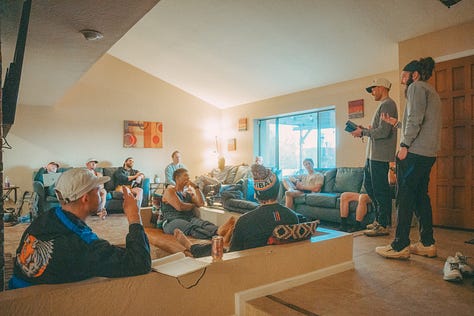


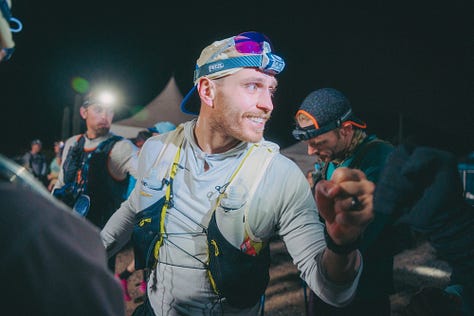
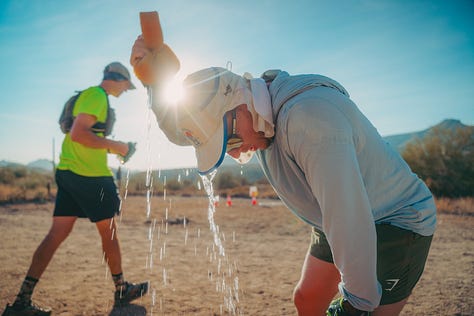
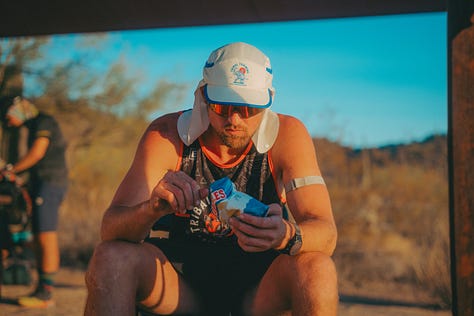
Click HERE to apply to Tribal.

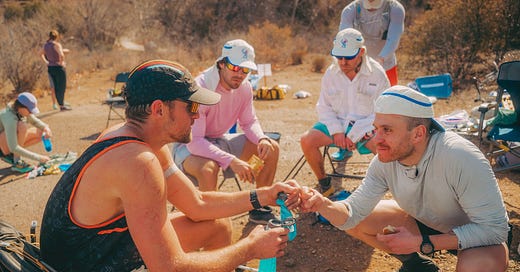


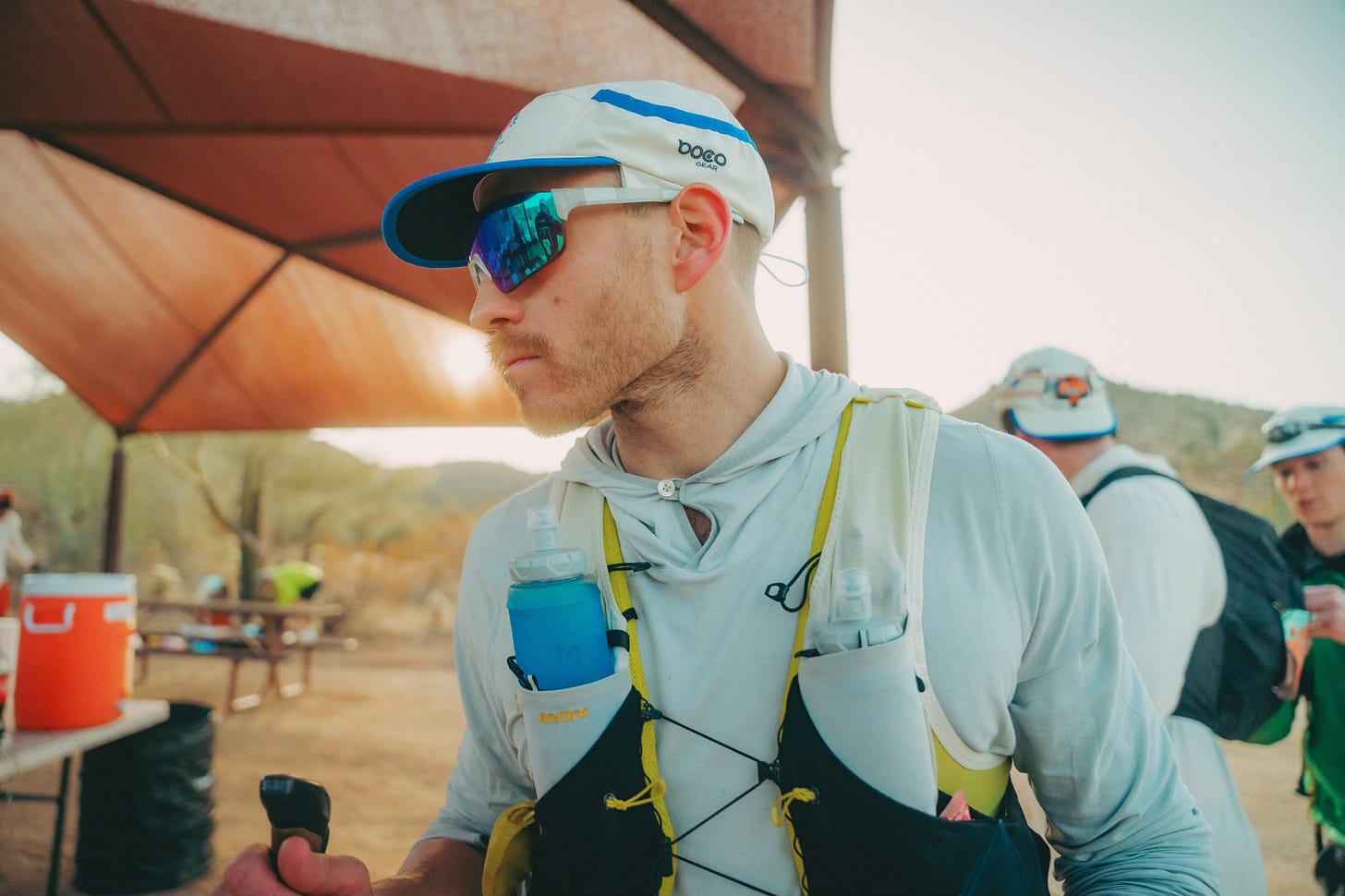
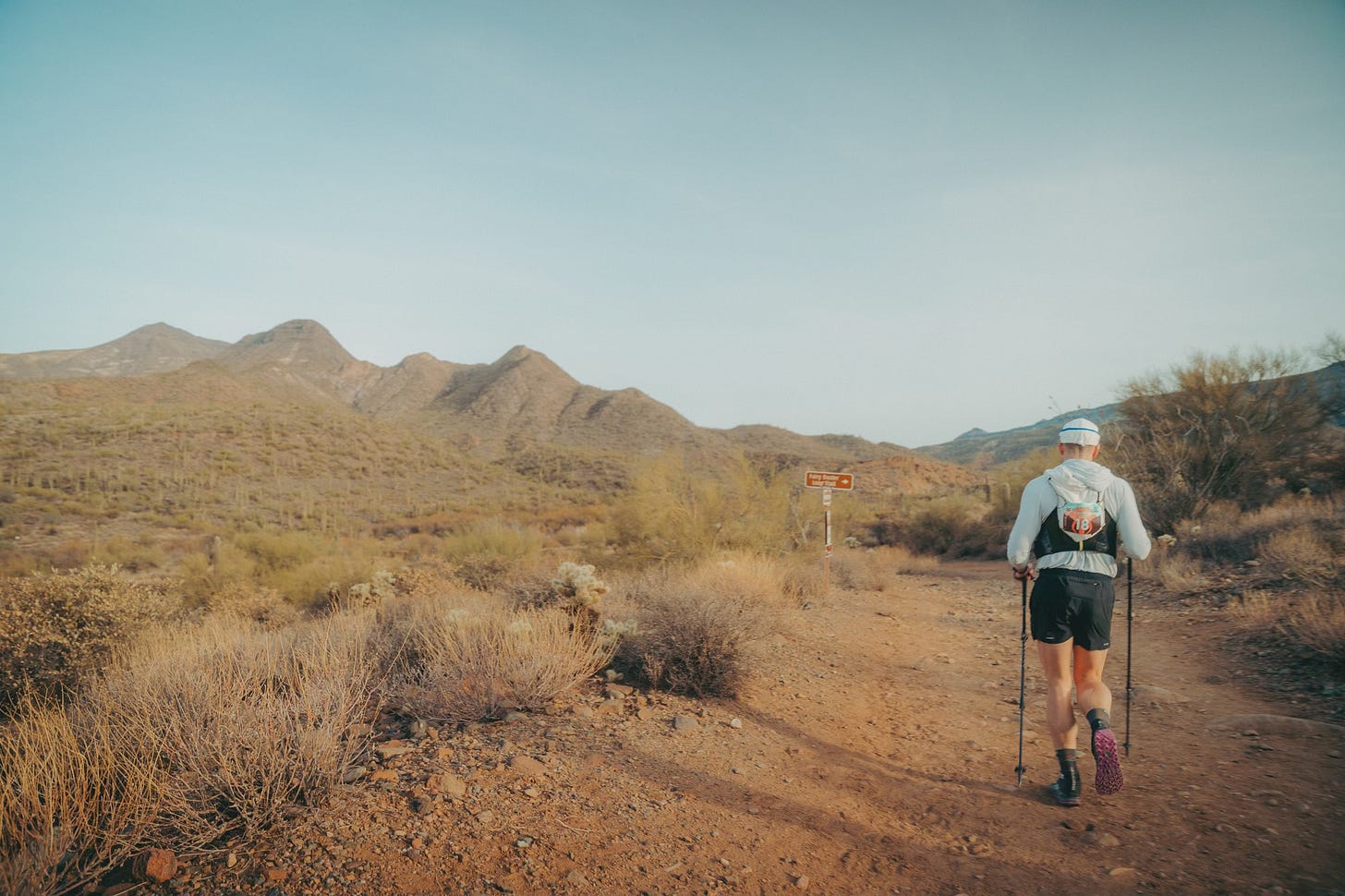


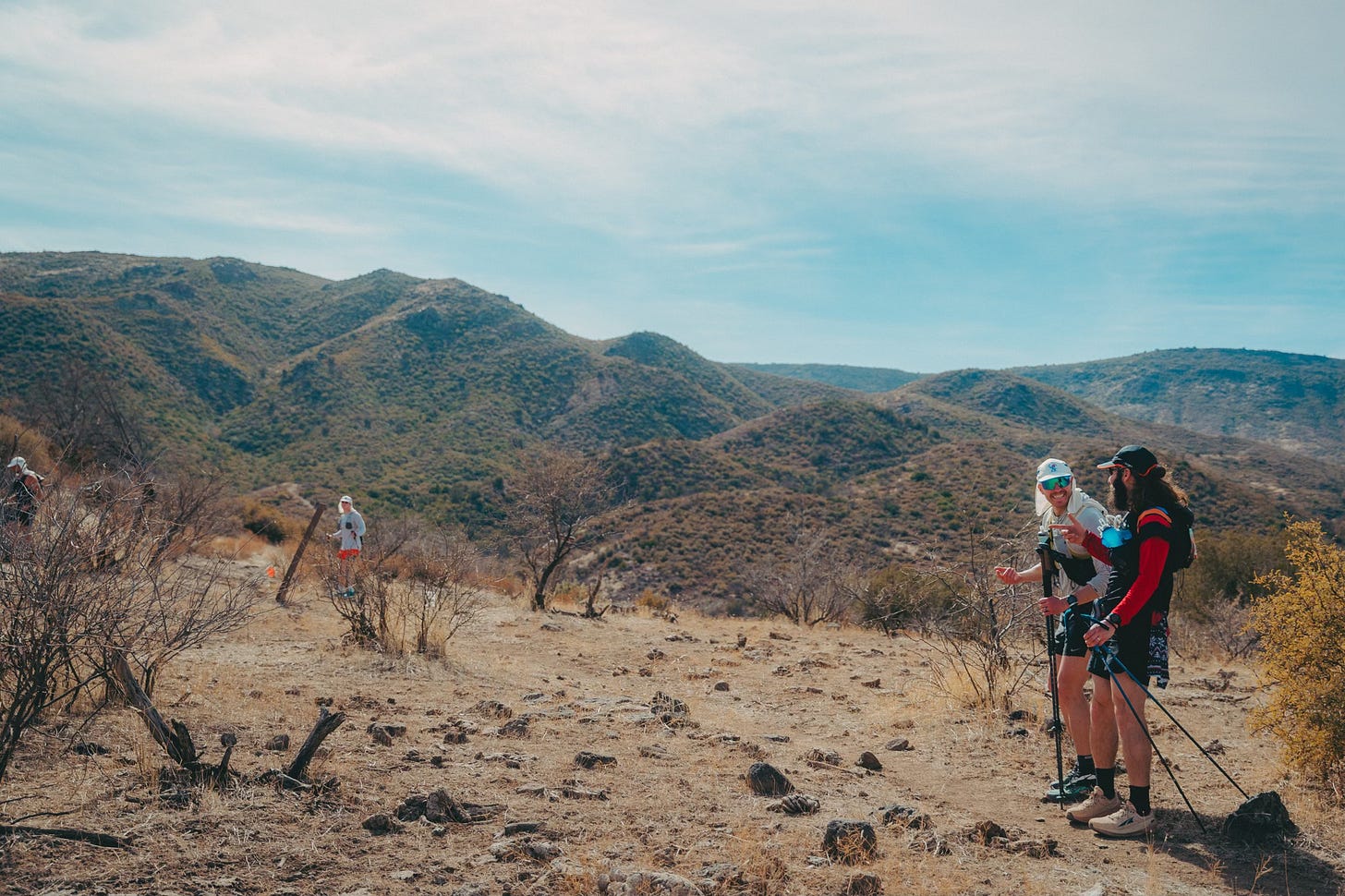


Divinely Delivered. Really appreciated the framework of this one. Loved it
Awesome write up coach!